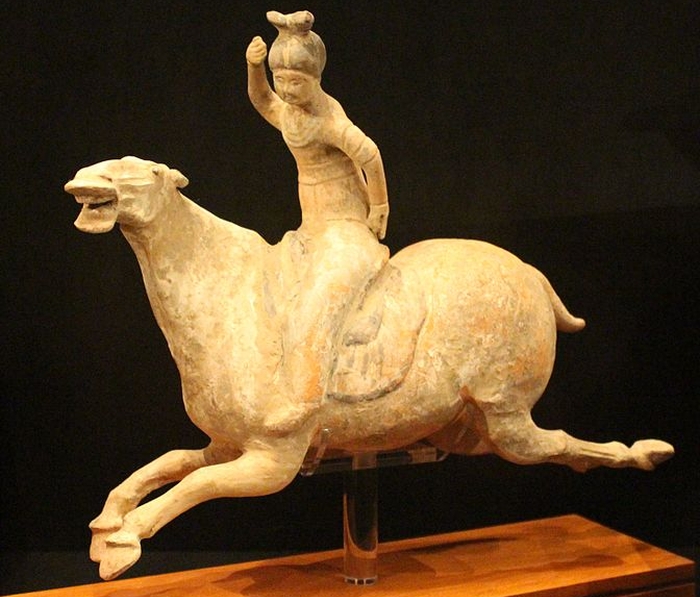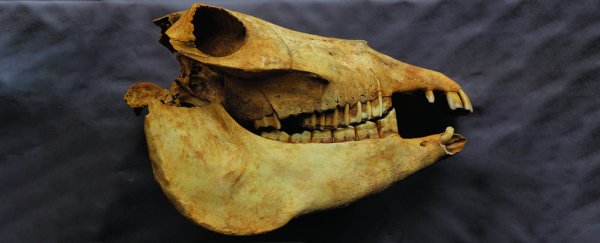Humans and animals have a long and beautiful history together, but a noblewoman named Cui Shi from the Tang Dynasty presents a rare first. She loved her donkeys so much that she was buried with them – together in death, perhaps, as they were in life.
The grave, dated to 878 CE, is the first ever found in which a high status woman from Imperial China was interred with donkeys – an animal more commonly associated with lowly transport and toil.
"There was no reason for a lady such as Cui Shi to use a donkey, let alone sacrifice it for her afterlife," says archaeologist Songmei Hu from the Shaanxi Academy of Archaeology in China. "This is the first time such a burial has been found."
It's well known that donkeys were primarily used throughout the ancient world as pack animals. They were a driving force for the expansion of trade routes, as well as travel - an extremely useful and important animal across Europe and Asia, but not exactly one that was shrouded in glamour.
Unlike horses, they weren't involved in war, nor enshrined as status symbols, nor usually ridden for entertainment. Working class people sometimes rode them to get places, but the wealthy seldom did.
"Donkeys were the first pack animal, the steam engines of their day in Africa and western Eurasia, but we know almost nothing about their use in eastern Asia," says archaeologist Fiona Marshall of Washington University in St Louis.
"Donkey skeletons just have not been found - this is probably because they died along trade routes and were not preserved. The donkeys buried in the Tang Dynasty noble tomb in Xian provided a first opportunity - and a very rare one - to understand donkeys' roles in east Asian societies."
But there are some clues that point to what a wealthy, high-status noblewoman would have been doing with donkeys. Historical texts document the use of donkeys for playing polo, a game that's now played from horseback, with riders using long sticks to hit a ball.
 Tang Dynasty earthenware figure of a female polo player on a horse. (Einarspetz/Wikimedia Commons/CC BY 3.0)
Tang Dynasty earthenware figure of a female polo player on a horse. (Einarspetz/Wikimedia Commons/CC BY 3.0)
Polo originated probably in Iran or Persia, and was popular and well known by the middle of the third century CE. It spread across to China (among a lot of other places), where it became very popular with nobles during the Tang Dynasty, which ran from 618 to 907 CE.
But it wasn't exactly a safe game - so some riders, particularly women and the elderly, preferred a version played with donkeys, called Lvju. This has been documented in historical records, but never actually confirmed archaeologically.
All of which makes the two donkeys buried in Cui Shi's tomb a very interesting find.
The tomb was actually discovered by archaeologists in 2012, and it had been heavily looted. The bones were in disarray, with the remains of at least three donkeys jumbled up with the bones of at least four cattle, pictured below, (c) and (d). The team's analysis focuses on the donkeys.
Because the tomb had been unsealed and entered, radiocarbon dating was required to determine whether the bones were buried at the same time as Cui Shi. The analysis places them as dying at around the same time, approximately 878 CE, suggesting the animals were perhaps intended to accompany Cui Shi in the afterlife, the archaeologists suggest.
They also conducted CT scans for a biomechanical analysis of the bones - seeing how the bones were shaped and worn, and how and where they had been strengthened - to see how the donkeys lived their lives.
They found that the shape of the bones, and the points at which they had strengthened, were not consistent with the slow, methodical pace of pack donkeys. A lifestyle of pulling carts or milling grain could have been the culprit, but the donkeys were of relatively small stature for beasts of burden, and the likelihood of a noblewoman being buried with cart or mill donkeys seems low.
 (Hu et al., Antiquity, 2020)
(Hu et al., Antiquity, 2020)
On the other hand, a lot of activity, including acceleration, deceleration, and turns, could also have produced the bone shaft morphology the researchers found. In addition, they discovered a single stirrup in the tomb, pictured above, (a).
Emperor Xizong, who ruled during Cui Shi's lifetime, was a great lover of polo, and Cui Shi's husband, Bao Gao, was so skilled in the game that Xizong promoted him to the rank of general. Since polo was wildly popular among both men and women of status, it stands to reason that she would have played, too.
"Her family's special relationship with polo and the popularity of donkey polo suggest that, following Tang mortuary tradition, the donkeys were sacrificed to reflect Cui Shi's desire to play Lvju in the afterlife," the researchers write in their paper.
"The donkeys from Cui Shi's tomb are the earliest so far documented in East Asia, providing the first archaeological evidence for the donkeys' value among elite women in ancient China. From a broader perspective, the donkeys' transition from pack animals to high-status polo mounts in ancient China extends our understanding of the complex role of donkeys in human history."
The research is due to be published in Antiquity.
